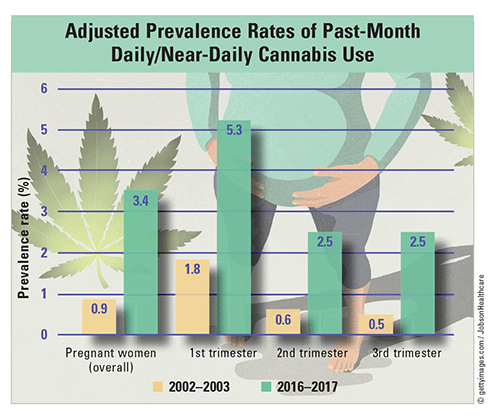US Pharm. 2022;47(9):14.
Data from the National Survey on Drug Use and Health reveal that cannabis use during pregnancy more than doubled between 2002 and 2017. Past-month cannabis use rose from 3.4% to 7.0% among pregnant women aged 12 to 44 years. The adjusted prevalence of past-month daily/near-daily cannabis use increased significantly (by 2.5%) among all pregnant respondents, with increases of 3.5% during the first trimester, 1.9% during the second trimester, and 2.0% during the third trimester. Increases in adjusted past-month mean number of days of cannabis use also were significant, except in the third trimester. Overall, cannabis use increased from 0.4 to 1.1 days; increases were from 0.8 to 2.0 days during the first trimester and 0.2 to 0.7 days during the second trimester. Cannabis use for medical purposes only was relatively low and did not differ significantly between pregnant and nonpregnant women from 2013 to 2017.

Potential Consequences: According to the CDC, the Office of the U.S. Surgeon General, and the Substance Abuse and Mental Health Services Administration, cannabis use during pregnancy has been associated with low birthweight and shorter length as well as with abnormal neurologic development, miscarriage, premature birth, and stillbirth. Longer-term consequences include poor cognitive function, attention and memory deficits, hyperactivity, mood, stress reactivity, and other behavioral issues. These effects may also occur in children exposed to cannabis from breast milk and secondhand smoke from cannabis-containing products.
Polysubstance Considerations: A 2020 Morbidity and Mortality Weekly Report found that 40% of women who used one substance during pregnancy reported the use of additional substances, most often cannabis and tobacco. Among women who used cannabis before and during pregnancy, 74% also reported smoking cigarettes during pregnancy. Based on the latest Pregnancy Risk Assessment Monitoring System report, the most common reasons for cannabis use during pregnancy were to relieve stress or anxiety, nausea and/or vomiting, and pain. Fun, relaxation, and alleviation of symptoms associated with a chronic condition were other reasons for frequent use during pregnancy.
Prevention and Mitigation: As more states legalize cannabis for medical and recreational use, pregnant women should be assessed for this as well as for other substances and mental-health conditions. The FDA, the American Academy of Pediatrics, the American College of Obstetricians and Gynecologists, and the CDC strongly advise against the use of any form of cannabis while pregnant or breastfeeding. U.S. Preventive Services Task Force recommendations encourage healthcare providers to screen all pregnant women for unhealthy drug, alcohol, and tobacco use in order to provide accurate diagnosis, educational counseling, and effective treatment and behavioral interventions for reducing fetal substance exposure during pregnancy, as well as to promote postpartum health and well-being.
The content contained in this article is for informational purposes only. The content is not intended to be a substitute for professional advice. Reliance on any information provided in this article is solely at your own risk.
To comment on this article, contact rdavidson@uspharmacist.com.






